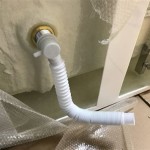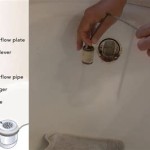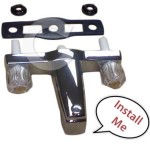Bathtub Drain Parts Names: A Comprehensive Guide for Homeowners
Understanding the anatomy of a bathtub drain is crucial for any homeowner. Whether you are troubleshooting a slow drain, planning a repair, or simply interested in the inner workings of your home's plumbing, knowing the names and functions of the various bathtub drain parts will empower you to handle common issues effectively. This guide provides a detailed overview of the components that make up a typical bathtub drain assembly.
The Drain Flange and Stopper Mechanism
The drain flange is the visible metal ring that sits flush with the tub surface, surrounding the drain opening. It serves as the decorative and functional interface between the tub and the drainpipe. The flange is typically made of chrome, stainless steel, brass, or other corrosion-resistant materials. Its primary purpose is to provide a secure and watertight connection between the tub and the drainpipe below.
The stopper mechanism is integrated with the drain flange and is responsible for controlling the flow of water. There are several types of stoppers, each with its own design and operation. Common types include:
*Lift-and-Turn Stopper:
This type has a knob on top that you lift and turn to open or close the drain. It operates by rotating a plunger that blocks or unblocks the drain opening. *Push-and-Pull Stopper:
This stopper is activated by pushing it down to close the drain and pulling it up to open it. A spring-loaded mechanism inside the stopper body controls the position of the rubber or silicone seal that blocks the drain. *Toe-Touch Stopper:
Similar to the push-and-pull stopper, the toe-touch stopper is operated by pushing it with your toe. A more modern design, it often features a smoother, more streamlined appearance. *Pop-Up Stopper:
Often lever-operated, pop-up stoppers use a linkage connected to an overflow plate lever to raise or lower the stopper. *Flip-It Stopper:
A user-friendly design that flips open and closed. The simple lever action provides an easy way to control water flow.Regardless of the type, the stopper's primary function is to create a watertight seal to prevent water from draining out of the tub when a bath is being taken. The reliability and effectiveness of the stopper are key to a comfortable bathing experience.
Beneath the drain flange is the drain body. This piece connects directly to the flange above. It is designed to screw onto the flange and create a water-tight seal. The drain body then connects to the drainpipe below.
Depending on the type of stopper mechanism, there may also be internal components such as a plunger, spring, or linkage system housed within the drain body. These parts work together to ensure smooth and reliable operation of the stopper.
The Overflow Plate and Linkage (When Applicable)
Many bathtubs feature an overflow drain, a safety feature designed to prevent the tub from overfilling and causing water damage. The overflow drain is typically located near the top of the tub, just below the faucet. The overflow drain is covered by an overflow plate.
The overflow plate is a decorative cover that conceals the overflow drain opening. It is usually made of the same material as the drain flange to provide a cohesive aesthetic. The overflow plate is typically secured to the tub with screws.
In many bathtub drain systems, the overflow plate is connected to the stopper mechanism via a linkage. This linkage is a series of metal rods and pivots that translate the movement of a lever on the overflow plate to the opening and closing of the drain stopper. When you lift or lower the lever on the overflow plate, the linkage moves the stopper up or down, controlling the flow of water.
The linkage system often includes adjustment points that allow you to fine-tune the stopper's position. This is particularly important to ensure a tight seal when the stopper is closed and to prevent the stopper from sticking or jamming.
The overflow elbow is the connection piece behind the overflow plate that directs overflow water down the drainpipe. This elbow is often a potential source of leaks if the connections aren't properly sealed.
Not all bathtub drains use an overflow linkage system. Some modern designs, such as toe-touch stoppers, operate independently of the overflow drain. In these cases, the overflow plate simply covers the overflow drain opening without any mechanical connection to the stopper.
The Drainpipe and Related Connections
The drainpipe is the network of pipes that carries wastewater away from the bathtub. It is typically made of PVC, ABS, copper, or brass, and it connects to the main drain line of the house.
The tailpiece is the section of pipe that connects directly to the bottom of the drain body. It is usually threaded to allow for a secure connection. The tailpiece is crucial for transitioning from the drain body to the more complex plumbing system below.
The P-trap is a curved section of pipe that traps a small amount of water. This trapped water acts as a seal, preventing sewer gases from entering the house through the drain. The P-trap is an essential component of the plumbing system, ensuring a safe and odor-free environment.
The P-trap consists of several parts: the inlet arm (connected to the tailpiece), the U-bend (the curved section), and the outlet arm (connected to the drain line). Each of these parts plays a role in creating the water seal.
The drain shoe is the fitting that connects the tailpiece to the P-trap. It usually has a curved or angled design to facilitate the transition between the vertical tailpiece and the horizontal P-trap.
Couplings and fittings are used to connect the various sections of drainpipe together. These fittings include elbows, tees, and straight couplings, and they are essential for creating a leak-proof and properly aligned drain system.
Washers and gaskets are used at various connection points to create a watertight seal. These are typically made of rubber, silicone, or other flexible materials, and they are essential for preventing leaks. When disassembling any part of the drain system, it is crucial to inspect and replace any worn or damaged washers and gaskets.
Plumber's putty and thread seal tape (Teflon tape) are commonly used to seal threaded connections and prevent leaks. Plumber's putty is a soft, pliable compound that is applied to the threads of pipes before they are joined together. Thread seal tape is a thin, white tape that is wrapped around the threads of pipes to create a tighter seal. Both of these materials are essential tools for any plumbing project.
The vent pipe is another critical component, though not directly located under the tub. It allows air into the drain system, preventing a vacuum that can slow or stop the flow of water. It's connected indirectly to the drainpipe, usually further down the line. Proper ventilation is essential for a functional and efficient drainage system.
Understanding the names and functions of these bathtub drain parts will enable you to diagnose and address common plumbing problems effectively. When working on plumbing projects, it is always recommended to consult with a qualified plumber if you are unsure about any aspect of the work.
The specific arrangement and configuration of these parts may vary depending on the type of bathtub and the plumbing system in your home. However, the basic principles and functions remain the same.

Bathtub Parts Everyone Should Know About Part Names 2024

Bathtub Drain System 2024 Guide Badeloft

The Diffe Parts Of A Bathtub And How They Work Family Handyman

P5 11 160

15 Essential Parts Of A Bathtub And How They Work

Bathtub Hot Drain Parts

Replacement Parts For Brass Bathtub Drains

Ultimate Guide On Parts Of A Bathtub Names Functions Diagram

Bathtub Drain Replacement

What Is A Bathtub Drain Kit Hofen
Related Posts








